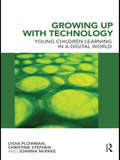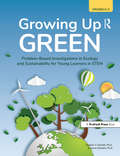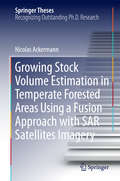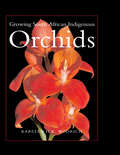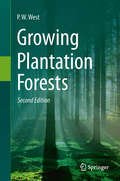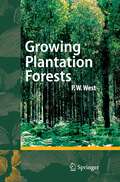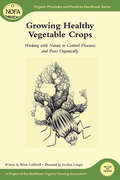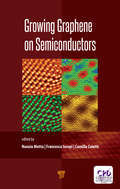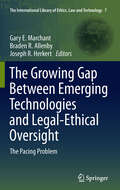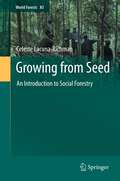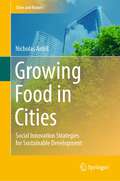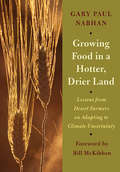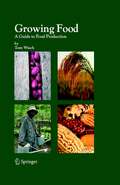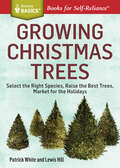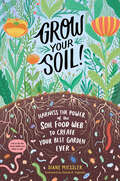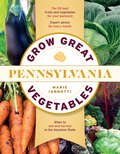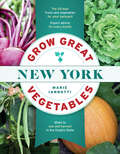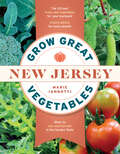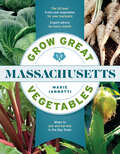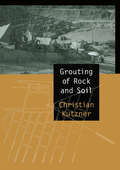- Table View
- List View
Growing Up With Technology: Young Children Learning in a Digital World
by Lydia Plowman Christine Stephen Joanna McPakeGrowing Up with Technology explores the role of technology in the everyday lives of three- and four-year-old children, presenting the implications for the children’s continuing learning and development. Children are growing up in a world where the internet, mobile phones and other forms of digital interaction are features of daily life. The authors have carefully observed children’s experiences at home and analysed the perspectives of parents, practitioners and the children themselves. This has enabled them to provide a nuanced account of the different ways in which technology can support or inhibit learning. Drawing on evidence from their research, the authors bring a fresh approach to these debates, based on establishing relationships with children, families and educators to get insights into practices, values and attitudes. A number of key questions are considered, including: Which technologies do young children encounter at home and preschool? What kind of learning takes place in these encounters? How can parents and practitioners support this learning? Are some children disadvantaged when it comes to learning with technology? Growing Up with Technology is strongly grounded in a series of research projects, providing new ways of thinking about how children’s learning with technology can be supported. It will be of great interest to undergraduate and postgraduate students on a range of courses including childhood studies, and those with a particular interest in the use of technology in education. Parents, practitioners and researchers will also find this a fascinating and informative read.
Growing Up With Technology: Young Children Learning in a Digital World
by Lydia Plowman Christine Stephen Joanna McPakeGrowing Up with Technology explores the role of technology in the everyday lives of three- and four-year-old children, presenting the implications for the children’s continuing learning and development. Children are growing up in a world where the internet, mobile phones and other forms of digital interaction are features of daily life. The authors have carefully observed children’s experiences at home and analysed the perspectives of parents, practitioners and the children themselves. This has enabled them to provide a nuanced account of the different ways in which technology can support or inhibit learning. Drawing on evidence from their research, the authors bring a fresh approach to these debates, based on establishing relationships with children, families and educators to get insights into practices, values and attitudes. A number of key questions are considered, including: Which technologies do young children encounter at home and preschool? What kind of learning takes place in these encounters? How can parents and practitioners support this learning? Are some children disadvantaged when it comes to learning with technology? Growing Up with Technology is strongly grounded in a series of research projects, providing new ways of thinking about how children’s learning with technology can be supported. It will be of great interest to undergraduate and postgraduate students on a range of courses including childhood studies, and those with a particular interest in the use of technology in education. Parents, practitioners and researchers will also find this a fascinating and informative read.
Growing Up Green: Problem-Based Investigations in Ecology and Sustainability for Young Learners in STEM (Grades K-2)
by Stephen T. Schroth Janese DanielsGrowing Up Green allows young students (grades K-2) to build critical and creative thinking skills, while also improving skills in science, technology, engineering, and mathematics (STEM). The book:Includes 10 problem-based investigations that explore sustainability and environmental concerns.Covers topics such as reducing one's carbon footprint, developing green manufacturing processes, initiating a recycling program, and more.Is perfect for general education classrooms, single- or multi-grade gifted classrooms, or pull-out programs.Features crosscurricular connections.Includes a list of apps, websites, and books that can be used to increase students' understanding and curiosity.Each investigation includes comprehensive teacher instructions, ideas for differentiation, hands-on student activities, reproducible student resources, reflection opportunities, and assessment options. The engaging investigations guide learners through the process of identifying problems, developing research questions, gathering and analyzing data, developing possible solutions, and disseminating information to others.Grades K-2
Growing Up Green: Problem-Based Investigations in Ecology and Sustainability for Young Learners in STEM (Grades K-2)
by Stephen T. Schroth Janese DanielsGrowing Up Green allows young students (grades K-2) to build critical and creative thinking skills, while also improving skills in science, technology, engineering, and mathematics (STEM). The book:Includes 10 problem-based investigations that explore sustainability and environmental concerns.Covers topics such as reducing one's carbon footprint, developing green manufacturing processes, initiating a recycling program, and more.Is perfect for general education classrooms, single- or multi-grade gifted classrooms, or pull-out programs.Features crosscurricular connections.Includes a list of apps, websites, and books that can be used to increase students' understanding and curiosity.Each investigation includes comprehensive teacher instructions, ideas for differentiation, hands-on student activities, reproducible student resources, reflection opportunities, and assessment options. The engaging investigations guide learners through the process of identifying problems, developing research questions, gathering and analyzing data, developing possible solutions, and disseminating information to others.Grades K-2
Growing Stock Volume Estimation in Temperate Forested Areas Using a Fusion Approach with SAR Satellites Imagery (Springer Theses)
by Nicolas Ackermann"The PhD thesis written by Mr. Ackermann is an outstanding and in-depth scientific study that closes a research gap and paves the way to new developments. Despite the extremely complex issues, his work is very understandable and excellently elaborated."Prof. Dr. Christiane Schmullius "The PhD thesis written by Mr. Ackermann is an excellent and very comprehensive work performed at the highest scientific level. It examines in detail the potential of SAR data with regards to the derivation of forest stem volume in the temperate latitudes. The work belongs to a technically complex field. Nevertheless, Mr. Ackermann has succeeded in presenting the content in a clear and understandable way."Dr. Christian Thiel "The proposed document is overall of very good quality. Mr. Ackermann has done an exhaustive analysis of the in-situ data available on the Thuringian forest and was able to derive Growing Stocking Volume using L- and X-band spaceborne SAR data. The document is very well structured with a good split of information between the core of the text presented in the 6 chapters and the 4 annexes, which contain detailed results. Mr. Ackermann’s English grammar is excellent and his syntax is crystal clear, making his document pleasant to read. The way arguments are presented is logical and Mr. Ackermann gives a lot of attention to ensuring that sound explanations properly support these arguments."Dr. Maurice Borgeaud
Growing South African Indigenous Orchids
by Karsten WodrichProviding a guide to the cultivation of both the terrestrial and epihytic orchid species growing in South Africa, this volume includes numerous hints, illustrations and photographs to help simplify the process. Detailed growing notes are given for over 60 terrestrial and over 40 epiphytic species.
Growing South African Indigenous Orchids
by Karsten WodrichProviding a guide to the cultivation of both the terrestrial and epihytic orchid species growing in South Africa, this volume includes numerous hints, illustrations and photographs to help simplify the process. Detailed growing notes are given for over 60 terrestrial and over 40 epiphytic species.
Growing Plantation Forests
by P. W. WestThis book describes the scientific principles that are used throughout the world to ensure the rapid, healthy growth of forest plantations. As the population of the world increases so does the amount of wood people use. Large areas of natural forests are being cleared every year and converted to other uses. Almost as large an area of plantation forests is being established annually to replace those lost natural forests. Eventually, plantations will produce a large proportion of the wood used around the world for firewood, building, the manufacture of paper and bioenergy. Forest plantations can also provide various environmental benefits including carbon storage, rehabilitation of degraded land, serving as disposal sites for various forms of industrial or agricultural waste and enhancing biodiversity in regions that have been largely cleared for agriculture. Whatever their motivation, plantation forest growers want their plantations to be healthy and grow rapidly to achieve their purpose as soon as possible. This book discusses how this is done. It is written for a worldwide audience, from forestry professionals and scientists through to small plantation growers, and describes how plantations may be grown responsibly and profitably.
Growing Plantation Forests
by Phil WestIn a highly readable fashion, this book describes the scientific principles which are used throughout the world to ensure rapid, healthy plantation growth. It is written for a world-wide audience, from forestry professionals and scientists through to small plantation growers, to describe how plantations may be grown responsibly and profitably. The author has been a forest scientist for over 30 years.
Growing Healthy Vegetable Crops: Working with Nature to Control Diseases and Pests Organically (Organic Principles and Practices Handbook Series)
by Brian Caldwell Jocelyn LangerPart of the NOFA Guides. Includes information on: Basic concepts of pest control (host susceptibility, soil health, genetic resistance, ecosystem factors) Practical approaches (crop cultural practices, rescue treatments, special section on mammals and birds, food safety) Farm design for pest reduction (diversity, crop rotation) Unorthodox approaches (farmers out of the box) Identifying pests Crop-by-crop pests and practices
Growing Graphene on Semiconductors
by Nunzio Motta Francesca Iacopi Camilla ColettiGraphene, the wonder material of the 21st century, is expected to play an important role in future nanoelectronic applications, but the only way to achieve this goal is to grow graphene directly on a semiconductor, integrating it in the chain for the production of electronic circuits and devices. This book summarizes the latest achievements in this field, with particular attention to the graphitization of SiC. Through high-temperature annealing in a controlled environment, it is possible to decompose the topmost SiC layers, obtaining quasi-ideal graphene by Si sublimation with record electronic mobilities, while selective growth on patterned structures makes possible the opening of a gap by quantum confinement. The book starts with a review chapter on the significance and challenges of graphene growth on semiconductors, followed by three chapters dedicated to an up-to-date analysis of the synthesis of graphene in ultrahigh vacuum, and concludes with two chapters discussing possible ways of tailoring the electronic band structure of epitaxial graphene by atomic intercalation and of creating a gap by the growth of templated graphene nanostructures.
Growing Graphene on Semiconductors
by Nunzio Motta Francesca Iacopi Camilla ColettiGraphene, the wonder material of the 21st century, is expected to play an important role in future nanoelectronic applications, but the only way to achieve this goal is to grow graphene directly on a semiconductor, integrating it in the chain for the production of electronic circuits and devices. This book summarizes the latest achievements in this field, with particular attention to the graphitization of SiC. Through high-temperature annealing in a controlled environment, it is possible to decompose the topmost SiC layers, obtaining quasi-ideal graphene by Si sublimation with record electronic mobilities, while selective growth on patterned structures makes possible the opening of a gap by quantum confinement. The book starts with a review chapter on the significance and challenges of graphene growth on semiconductors, followed by three chapters dedicated to an up-to-date analysis of the synthesis of graphene in ultrahigh vacuum, and concludes with two chapters discussing possible ways of tailoring the electronic band structure of epitaxial graphene by atomic intercalation and of creating a gap by the growth of templated graphene nanostructures.
The Growing Gap Between Emerging Technologies and Legal-Ethical Oversight: The Pacing Problem (The International Library of Ethics, Law and Technology #7)
by Gary E. Marchant, Braden R. Allenby and Joseph R. HerkertAt the same time that the pace of science and technology has greatly accelerated in recent decades, our legal and ethical oversight mechanisms have become bogged down and slower. This book addresses the growing gap between the pace of science and technology and the lagging responsiveness of legal and ethical oversight society relies on to govern emerging technologies. Whether it be biotechnology, genetic testing, nanotechnology, synthetic biology, computer privacy, autonomous robotics, or any of the other many emerging technologies, new approaches are needed to ensure appropriate and timely regulatory responses. This book documents the problem and offers a toolbox of potential regulatory and governance approaches that might be used to ensure more responsive oversight.
Growing from Seed: An Introduction to Social Forestry (World Forests #11)
by Celeste Lacuna-RichmanSocial Forestry and its most well-known variant, Community Forestry, have been practiced almost as long as people have used forests. During this time, forests have provided people with countless goods and services, including wood, medicine, food, clean water and recreation. In making use of forest resources, people throughout history have frequently organized themselves and established both formal and informal rules.However, just as the discipline of Forestry had previously limited and concentrated the function of forests to the timber it provides, the popular understanding of Social Forestry has restricted it to a Forestry sub-topic that deals with welfare, without any connection to income-generation, and is practiced only in developing countries.This volume introduces the concepts of Social Forestry to the student, gives examples of its practice around the world and attempts to anticipate developments in its future. It aims to widen the concept of Social Forestry from a sub-practice within Forestry to a practice that will make Forestry relevant in countries where wood production alone is no longer the main reason for keeping land forested, thereby rediscovering and redefining this important topic.
Growing Food in Cities: Social Innovation Strategies for Sustainable Development (Cities and Nature)
by Nicholas ArdillThis book examines social innovation strategies in the collaborative development of spaces for growing food in cities. It enables readers to gain valuable insights into an innovative social and spatial practice whilst advancing knowledge in an emerging area of research. The book will also be of great relevance to social activists, urban designers, planners, and decision-makers with an interest in applying this expertise to their own neighbourhoods and cities. Urban food growing spaces have multiplied in recent times. This green and inclusive urbanism creates social value for the health, wellbeing, and welfare of local inhabitants. Therefore, there is a convincing argument to investigate innovative spatial practices that can enable cities to meet the needs of an increasing population. Despite the mounting interest in collective approaches to sustainable development, limited attention has been given to the diverse ways in which this social action has been pursued. How are urban food growing spaces produced through social innovation? What are the innovative processes that can be translated in a replicable model to other cities, yet suitable for local needs, to support the development of healthier, more socially just built environments?
Growing Food in a Hotter, Drier Land: Lessons from Desert Farmers on Adapting to Climate Uncertainty
by Gary Paul Nabhan Bill McKibbenHow to harvest water and nutrients, select drought-tolerant plants, and create natural diversity Because climatic uncertainty has now become "the new normal," many farmers, gardeners and orchard-keepers in North America are desperately seeking ways to adapt their food production to become more resilient in the face of such "global weirding." This book draws upon the wisdom and technical knowledge from desert farming traditions all around the world to offer time-tried strategies for: Building greater moisture-holding capacity and nutrients in soils Protecting fields from damaging winds, drought, and floods Harvesting water from uplands to use in rain gardens and terraces filled with perennial crops Delecting fruits, nuts, succulents, and herbaceous perennials that are best suited to warmer, drier climates Gary Paul Nabhan is one of the world's experts on the agricultural traditions of arid lands. For this book he has visited indigenous and traditional farmers in the Gobi Desert, the Arabian Peninsula, the Sahara Desert, and Andalusia, as well as the Sonoran, Chihuahuan, and Painted deserts of North America, to learn firsthand their techniques and designs aimed at reducing heat and drought stress on orchards, fields, and dooryard gardens. This practical book also includes colorful "parables from the field" that exemplify how desert farmers think about increasing the carrying capacity and resilience of the lands and waters they steward. It is replete with detailed descriptions and diagrams of how to implement these desert-adapted practices in your own backyard, orchard, or farm. This unique book is useful not only for farmers and permaculturists in the arid reaches of the Southwest or other desert regions. Its techniques and prophetic vision for achieving food security in the face of climate change may well need to be implemented across most of North America over the next half-century, and are already applicable in most of the semiarid West, Great Plains, and the U.S. Southwest and adjacent regions of Mexico.
Growing Food: A Guide to Food Production
by Tony WinchThis handbook offers an ideal reference for individuals and organizations involved with the production of food, from both agriculture and horticulture. Designed to be accessible for those who normally speak or read English as their second language, it offers thorough explanations and numerous cross references to the terminology, acronyms and technologies used. The book answers basic questions about how food is produced from plants and aims to demystify the subject of growing food. The focus is firmly on the technical aspects of food crops, animal husbandry, agrochemicals and genetic engineering are only briefly mentioned.
Growing Christmas Trees: Select the Right Species, Raise the Best Trees, Market for the Holidays. A Storey BASICS® Title (Storey Basics)
by Patrick White Lewis HillA handy primer for growers raising Christmas trees for profit, this guide covers everything from choosing the best pine, fir, and spruce to planting, growing, shearing, pruning, harvesting, and selling.
Grow Your Soil!: Harness the Power of the Soil Food Web to Create Your Best Garden Ever
by Diane MiesslerThe key to success for every gardening venture is rich soil. Achieving that basic building block is easy with this accessible soil improvement guide, which offers a broad understanding of the science of soil&’s microbial life in an engaging, entertaining style.
Grow Great Vegetables in Pennsylvania (Grow Great Vegetables State-By-State)
by Marie IannottiWith month-by-month regional vegetable gardening information, fifty detailed plant profiles, and color photographs throughout, this is the essential guide for vegetable gardening in Pennsylvania.
Grow Great Vegetables in New York (Grow Great Vegetables State-By-State)
by Marie IannottiWith month-by-month regional vegetable gardening information, fifty detailed plant profiles, and color photographs throughout, this is the essential guide for vegetable gardening in New York.
Grow Great Vegetables in New Jersey (Grow Great Vegetables State-By-State)
by Marie IannottiWith month-by-month regional vegetable gardening information, fifty detailed plant profiles, and color photographs throughout, this is the essential guide for vegetable gardening in New Jersey.
Grow Great Vegetables in Massachusetts (Grow Great Vegetables State-By-State)
by Marie IannottiWith month-by-month regional vegetable gardening information, 50 detailed plant profiles, and color photographs throughout, this is the essential guide for vegetable gardening in Massachusetts.
Grouting of Rock and Soil
by Christian KutznerDeals with the design and execution of grouting works in all kinds of rock and soil, including jet grouting. Design principles are discussed whereby different approaches, exercised in different parts of the world, are compared to each other and evaluated.
Grouting of Rock and Soil
by Christian KutznerDeals with the design and execution of grouting works in all kinds of rock and soil, including jet grouting. Design principles are discussed whereby different approaches, exercised in different parts of the world, are compared to each other and evaluated.
